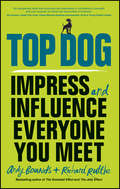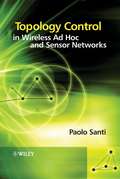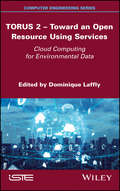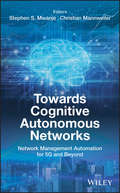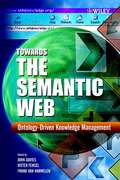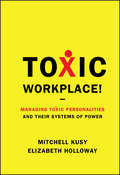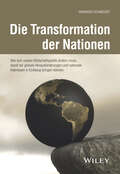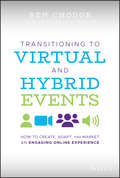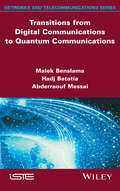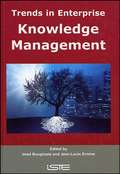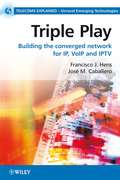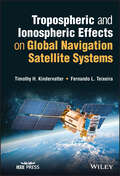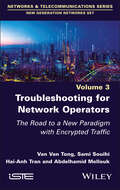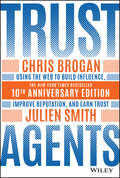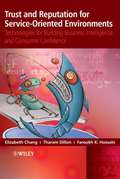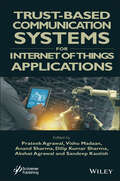- Table View
- List View
Top Dog: Impress and Influence Everyone You Meet
by Andy Bounds Richard RuttleGet the results you want and come out as the Top Dog in every conversationFancy being the ‘Top Dog’ in all your dealings? Fed up of feeling like the underdog? So many of us regularly ‘lose’ in conversations before we’ve even opened our mouths. Often without realising it, we don’t see ourselves as a peer of the other person. And we transmit this in what we do and say (“I’ll fit round you. I know you’re really busy.”) The other person picks up on this. And, without doing a thing, they’re suddenly in charge!Top Dog will teach you how to lead in all your interactions, so you can get more of what you want, more often.Together, Andy Bounds and Richard Ruttle are experts at helping people achieve more from their conversations with others. Their techniques work in every type of interaction—conversations, socialising, dating, interviews, sales, marketing, and networking. Basically, anytime you want to impress and persuade others.Top Dog: • Details the skill set needed to gain competitive advantage from the outset • Provides instructive and thought-provoking content, relevant to both beginners, and seasoned professionals • Contains insights from working with some of the world’s largest companies • Addresses how to achieve more from interactions in business and social arenas
Topology Control in Wireless Ad Hoc and Sensor Networks
by Paolo SantiTopology control is fundamental to solving scalability and capacity problems in large-scale wireless ad hoc and sensor networks. Forthcoming wireless multi-hop networks such as ad hoc and sensor networks will allow network nodes to control the communication topology by choosing their transmitting ranges. Briefly, topology control (TC) is the art of co-ordinating nodes’ decisions regarding their transmitting ranges, to generate a network with the desired features. Building an optimized network topology helps surpass the prevalent scalability and capacity problems. Topology Control in Wireless Ad Hoc and Sensor Networks makes the case for topology control and provides an exhaustive coverage of TC techniques in wireless ad hoc and sensor networks, considering both stationary networks, to which most of the existing solutions are tailored, and mobile networks. The author introduces a new taxonomy of topology control and gives a full explication of the applications and challenges of this important topic. Topology Control in Wireless Ad Hoc and Sensor Networks: Defines topology control and explains its necessity, considering both stationary and mobile networks. Describes the most representative TC protocols and their performance. Covers the critical transmitting range for stationary and mobile networks, topology optimization problems such as energy efficiency, and distributed topology control. Discusses implementation and ‘open issues’, including realistic models and the effect of multi-hop data traffic. Presents a case study on routing protocol design, to demonstrate how TC can ease the design of cooperative routing protocols. This invaluable text will provide graduate students in Computer Science, Electrical and Computer Engineering, Applied Mathematics and Physics, researchers in the field of ad hoc networking, and professionals in wireless telecoms as well as networking system developers with a single reference resource on topology control.
TORUS 2 - Toward an Open Resource Using Services: Cloud Computing for Environmental Data
by Dominique LafflyThis book, presented in three volumes, examines "environmental" disciplines in relation to major players in contemporary science: Big Data, artificial intelligence and cloud computing. Today, there is a real sense of urgency regarding the evolution of computer technology, the ever-increasing volume of data, threats to our climate and the sustainable development of our planet. As such, we need to reduce technology just as much as we need to bridge the global socio-economic gap between the North and South; between universal free access to data (open data) and free software (open source). In this book, we pay particular attention to certain environmental subjects, in order to enrich our understanding of cloud computing. These subjects are: erosion; urban air pollution and atmospheric pollution in Southeast Asia; melting permafrost (causing the accelerated release of soil organic carbon in the atmosphere); alert systems of environmental hazards (such as forest fires, prospective modeling of socio-spatial practices and land use); and web fountains of geographical data. Finally, this book asks the question: in order to find a pattern in the data, how do we move from a traditional computing model-based world to pure mathematical research? After thorough examination of this topic, we conclude that this goal is both transdisciplinary and achievable.
TORUS 2 - Toward an Open Resource Using Services: Cloud Computing for Environmental Data
by Dominique LafflyThis book, presented in three volumes, examines "environmental" disciplines in relation to major players in contemporary science: Big Data, artificial intelligence and cloud computing. Today, there is a real sense of urgency regarding the evolution of computer technology, the ever-increasing volume of data, threats to our climate and the sustainable development of our planet. As such, we need to reduce technology just as much as we need to bridge the global socio-economic gap between the North and South; between universal free access to data (open data) and free software (open source). In this book, we pay particular attention to certain environmental subjects, in order to enrich our understanding of cloud computing. These subjects are: erosion; urban air pollution and atmospheric pollution in Southeast Asia; melting permafrost (causing the accelerated release of soil organic carbon in the atmosphere); alert systems of environmental hazards (such as forest fires, prospective modeling of socio-spatial practices and land use); and web fountains of geographical data. Finally, this book asks the question: in order to find a pattern in the data, how do we move from a traditional computing model-based world to pure mathematical research? After thorough examination of this topic, we conclude that this goal is both transdisciplinary and achievable.
Towards Cognitive Autonomous Networks: Network Management Automation for 5G and Beyond
by Stephen S. Mwanje Christian MannweilerLearn about the latest in cognitive and autonomous network management Towards Cognitive Autonomous Networks: Network Management Automation for 5G and Beyond delivers a comprehensive understanding of the current state-of-the-art in cognitive and autonomous network operation. Authors Mwanje and Bell fully describe today's capabilities while explaining the future potential of these powerful technologies. This book advocates for autonomy in new 5G networks, arguing that the virtualization of network functions render autonomy an absolute necessity. Following that, the authors move on to comprehensively explain the background and history of large networks, and how we come to find ourselves in the place we're in now. Towards Cognitive Autonomous Networks describes several novel techniques and applications of cognition and autonomy required for end-to-end cognition including: • Configuration of autonomous networks • Operation of autonomous networks • Optimization of autonomous networks • Self-healing autonomous networks The book concludes with an examination of the extensive challenges facing completely autonomous networks now and in the future.
Towards Cognitive Autonomous Networks: Network Management Automation for 5G and Beyond
by Stephen S MwanjeLearn about the latest in cognitive and autonomous network management Towards Cognitive Autonomous Networks: Network Management Automation for 5G and Beyond delivers a comprehensive understanding of the current state-of-the-art in cognitive and autonomous network operation. Authors Mwanje and Bell fully describe today's capabilities while explaining the future potential of these powerful technologies. This book advocates for autonomy in new 5G networks, arguing that the virtualization of network functions render autonomy an absolute necessity. Following that, the authors move on to comprehensively explain the background and history of large networks, and how we come to find ourselves in the place we're in now. Towards Cognitive Autonomous Networks describes several novel techniques and applications of cognition and autonomy required for end-to-end cognition including: • Configuration of autonomous networks • Operation of autonomous networks • Optimization of autonomous networks • Self-healing autonomous networks The book concludes with an examination of the extensive challenges facing completely autonomous networks now and in the future.
Towards the Semantic Web: Ontology-driven Knowledge Management
by John Davies Dieter Fensel Frank Van HarmelenWith the current changes driven by the expansion of the World Wide Web, this book uses a different approach from other books on the market: it applies ontologies to electronically available information to improve the quality of knowledge management in large and distributed organizations. Ontologies are formal theories supporting knowledge sharing and reuse. They can be used to explicitly represent semantics of semi-structured information. These enable sophisticated automatic support for acquiring, maintaining and accessing information. Methodology and tools are developed for intelligent access to large volumes of semi-structured and textual information sources in intra- and extra-, and internet-based environments to employ the full power of ontologies in supporting knowledge management from the information client perspective and the information provider. The aim of the book is to support efficient and effective knowledge management and focuses on weakly-structured online information sources. It is aimed primarily at researchers in the area of knowledge management and information retrieval and will also be a useful reference for students in computer science at the postgraduate level and for business managers who are aiming to increase the corporations' information infrastructure. The Semantic Web is a very important initiative affecting the future of the WWW that is currently generating huge interest. The book covers several highly significant contributions to the semantic web research effort, including a new language for defining ontologies, several novel software tools and a coherent methodology for the application of the tools for business advantage. It also provides 3 case studies which give examples of the real benefits to be derived from the adoption of semantic-web based ontologies in "real world" situations. As such, the book is an excellent mixture of theory, tools and applications in an important area of WWW research. * Provides guidelines for introducing knowledge management concepts and tools into enterprises, to help knowledge providers present their knowledge efficiently and effectively. * Introduces an intelligent search tool that supports users in accessing information and a tool environment for maintenance, conversion and acquisition of information sources. * Discusses three large case studies which will help to develop the technology according to the actual needs of large and or virtual organisations and will provide a testbed for evaluating tools and methods. The book is aimed at people with at least a good understanding of existing WWW technology and some level of technical understanding of the underpinning technologies (XML/RDF). It will be of interest to graduate students, academic and industrial researchers in the field, and the many industrial personnel who are tracking WWW technology developments in order to understand the business implications. It could also be used to support undergraduate courses in the area but is not itself an introductory text.
Toxic Workplace!: Managing Toxic Personalities and Their Systems of Power
by Mitchell Kusy Elizabeth HollowayPraise for Toxic Workplace! "Toxic Workplace! describes how to identify and best work with toxic personalities. It also provides a systemic approach for creating a culture that's positive and respectful while improving the bottom line. Kusy and Holloway share how their national research translates into real-world practices in organizations. I endorse their practical, concrete approaches that will make a significant difference in organizations today and in the future." —Gregg Steinhafel, president and CEO, Target Corporation "Toxic Workplace! brings a rare and valuable view of one of the great challenges facing leaders in today's organizations. It is a significant guidebook to the healthy enterprise of the future, not only because of Kusy and Holloway's systems approach to dealing with toxic personalities, but also their unique practice of creating communities of respectful engagement. This book demonstrates how this impacts both organizational social responsibility and the bottom line." —Frances Hesselbein, former CEO of the Girl Scouts of the U.S.A.; founding president and chairman of Leader to Leader Institute, formerly The Peter F. Drucker Foundation for Nonprofit Management "Transforming the culture to support the strategy and mission is the real stuff of leadership. Toxic Workplace! gives you the research-based tools to identify and deal with the 'dark side' of this important dynamic. Read it and you will engage your organization in new, more authentic, and effective ways!" —Kevin Cashman, author, Leadership from the Inside Out and senior partner, Korn/Ferry Leadership & Talent Consulting
Toxic Workplace!: Managing Toxic Personalities and Their Systems of Power
by Mitchell Kusy Elizabeth HollowayPraise for Toxic Workplace! "Toxic Workplace! describes how to identify and best work with toxic personalities. It also provides a systemic approach for creating a culture that's positive and respectful while improving the bottom line. Kusy and Holloway share how their national research translates into real-world practices in organizations. I endorse their practical, concrete approaches that will make a significant difference in organizations today and in the future." —Gregg Steinhafel, president and CEO, Target Corporation "Toxic Workplace! brings a rare and valuable view of one of the great challenges facing leaders in today's organizations. It is a significant guidebook to the healthy enterprise of the future, not only because of Kusy and Holloway's systems approach to dealing with toxic personalities, but also their unique practice of creating communities of respectful engagement. This book demonstrates how this impacts both organizational social responsibility and the bottom line." —Frances Hesselbein, former CEO of the Girl Scouts of the U.S.A.; founding president and chairman of Leader to Leader Institute, formerly The Peter F. Drucker Foundation for Nonprofit Management "Transforming the culture to support the strategy and mission is the real stuff of leadership. Toxic Workplace! gives you the research-based tools to identify and deal with the 'dark side' of this important dynamic. Read it and you will engage your organization in new, more authentic, and effective ways!" —Kevin Cashman, author, Leadership from the Inside Out and senior partner, Korn/Ferry Leadership & Talent Consulting
Transformation der Nationen (AT)
by Reinhard SchneiderJahrzehntelang waren die technologisch fortgeschrittenen Länder des Westens die Nutznießer der Globalisierung auf Basis der von ihnen geschaffenen Wirtschaftsordnung. Jetzt ändern sich die geopolitischen und wirtschaftlichen Verhältnisse mit Wucht. Gleichzeitig hat sich in den letzten Jahren die Erkenntnis durchgesetzt, dass wir unsere Wirtschaft auf CO2-freies Wirtschaften umstellen müssen. Zudem altern viele Gesellschaften. Deutschland und Europa tun sich sichtlich dabei schwer, ihre Nationen zukunftsfähig zu gestalten. Gerade bei der passenden Wirtschaftspolitik hakt es. Reinhard Schneiders These ist: Es braucht in Deutschland und Europa dringend einen politischen, wirtschaftlichen und gesellschaftlichen Wandel. Diesen schaffen wir aber nur, wenn wir die Grundlagen unseres Wohlstands verstehen. Leider ist das Verständnis der wirtschaftlichen Zusammenhänge in der Politik und der breiten Bevölkerung oft lückenhaft und es kommt zu Fehleinschätzungen. Dies beginnt schon bei der mangelnden Unterscheidung zwischen Tätigkeiten, die Kosten für eine Gesellschaft auslösen, und Tätigkeiten, die Einkommen für eine Gesellschaft generieren. Eine wesentliche Ursache ist die Art, wie wir Wertschöpfung und Einkommen von Nationen bzw. Staaten wie Deutschland definieren und messen. Fest steht: Wenn Nationen ihren Wohlstand halten wollen, müssen sie konkurrenzfähig sein. Attraktive und konkurrenzfähige Produkte werden mittlerweile überall angeboten; bei Amazon ist man nur einen Klick vom weltweiten Angebot entfernt. Während die USA und China verstehen, dass sie ihr Einkommen steigern müssen, wenn sie mehr Wohlstand haben wollen, rümpfen die Europäer die Nase über den Neoliberalismus. Sie rufen lieber nach Geld vom Staat oder der EU zur Steigerung der Nachfrage. Auf diesem Weg werden Deutschland und Europa Gefahr laufen, abgehängt zu werden. Das Buch liefert eine längst überfällige Darstellung der Realität der Wirtschaft. Es soll helfen, richtige Entscheidungen zu treffen. Nur so gelingt uns, vor dem Hintergrund der aktuellen globalen Herausforderungen, der Wandel in eine erfolgreiche Zukunft - die Transformation der Nationen.
Transitioning to Virtual and Hybrid Events: How to Create, Adapt, and Market an Engaging Online Experience
by Ben ChodorCreating virtual events is not as simple as moving the same content online — learn how to immediately leverage virtual solutions for effective in-person online events As the global COVID-19 pandemic continues to have unprecedented impact on both the global economy and the whole of the world population, the need for effectively and efficiently connecting people and the right information has never been more urgent. Although the technology infrastructure currently exists, many organizations are scrambling to create virtual meetings and events to address important time-sensitive issues. Transitioning to Virtual and Hybrid Events explains everything an event host needs to know about going virtual, from understanding the new audience, to adapting content to the new medium, to marketing effectively, and much more. Author Ben Chodor, president of Intrado Digital Media, provides expert advice and real-world instructions for delivering engaging hybrid, virtual, and streaming events and webinars for companies of all sizes and across all industries. Packed with detailed tutorials, real-world case studies, illustrative examples, and highly useful checklists, this comprehensive resource provides step-by-step guidance on: Planning, creating, and implementing a digital event Choosing between a stream, a webcast, or a hybrid event Evaluating different technological solutions Producing compelling virtual content for a variety of scenarios Effectively promoting online events Meeting the needs of a diverse and global audience Transitioning to Virtual and Hybrid Events is an indispensable instruction manual for anyone tasked with enhancing their organization’s continuity plans, enabling their employee base to work remotely, or creating any type of virtual solution to meet this urgent crisis.
Transitioning to Virtual and Hybrid Events: How to Create, Adapt, and Market an Engaging Online Experience
by Ben ChodorCreating virtual events is not as simple as moving the same content online — learn how to immediately leverage virtual solutions for effective in-person online events As the global COVID-19 pandemic continues to have unprecedented impact on both the global economy and the whole of the world population, the need for effectively and efficiently connecting people and the right information has never been more urgent. Although the technology infrastructure currently exists, many organizations are scrambling to create virtual meetings and events to address important time-sensitive issues. Transitioning to Virtual and Hybrid Events explains everything an event host needs to know about going virtual, from understanding the new audience, to adapting content to the new medium, to marketing effectively, and much more. Author Ben Chodor, president of Intrado Digital Media, provides expert advice and real-world instructions for delivering engaging hybrid, virtual, and streaming events and webinars for companies of all sizes and across all industries. Packed with detailed tutorials, real-world case studies, illustrative examples, and highly useful checklists, this comprehensive resource provides step-by-step guidance on: Planning, creating, and implementing a digital event Choosing between a stream, a webcast, or a hybrid event Evaluating different technological solutions Producing compelling virtual content for a variety of scenarios Effectively promoting online events Meeting the needs of a diverse and global audience Transitioning to Virtual and Hybrid Events is an indispensable instruction manual for anyone tasked with enhancing their organization’s continuity plans, enabling their employee base to work remotely, or creating any type of virtual solution to meet this urgent crisis.
Transitions from Digital Communications to Quantum Communications: Concepts and Prospects
by Malek Benslama Hadj Batatia Abderraouf MessaiThis book addresses the move towards quantum communications, in light of the recent technological developments on photonic crystals and their potential applications in systems. The authors present the state of the art on extensive quantum communications, the first part of the book being dedicated to the relevant theory; quantum gates such as Deutsch gates, Toffoli gates and Dedekind gates are reviewed with regards to their feasibility as electronic circuits and their implementation in systems, and a comparison is performed in parallel with conventional circuits such as FPGAs and DSPs. The specifics of quantum communication are also revealed through the entanglement and Bell states, and mathematical and physical aspects of quantum optical fibers and photonic crystals are considered in order to optimize the quantum transmissions. These concepts are linked with relevant, practical examples in the second part of the book, which presents six integrated applications for quantum communications.
Transitions from Digital Communications to Quantum Communications: Concepts and Prospects
by Malek Benslama Hadj Batatia Abderraouf MessaiThis book addresses the move towards quantum communications, in light of the recent technological developments on photonic crystals and their potential applications in systems. The authors present the state of the art on extensive quantum communications, the first part of the book being dedicated to the relevant theory; quantum gates such as Deutsch gates, Toffoli gates and Dedekind gates are reviewed with regards to their feasibility as electronic circuits and their implementation in systems, and a comparison is performed in parallel with conventional circuits such as FPGAs and DSPs. The specifics of quantum communication are also revealed through the entanglement and Bell states, and mathematical and physical aspects of quantum optical fibers and photonic crystals are considered in order to optimize the quantum transmissions. These concepts are linked with relevant, practical examples in the second part of the book, which presents six integrated applications for quantum communications.
Trends in Enterprise Knowledge Management
by Pierre-Noël FavennecKnowledge Management (KM) encompasses a wide range of tools and methods that are at the heart of the information and communication society and provide solutions that rely as much on organization as on technology. This title brings together contributions from authors from a range of countries who are recognized as leading figures in this field, both in an academic and a practical sense. It describes the strategic aspects of KM and defines the underlying principles in terms of management, life cycle, process, methods and tools involved in this discipline. Several approaches to the running of KM within organizations are then discussed. The influence of KM on the performance of a company is analyzed and guidelines are given on various KM approaches that can be used to achieve specific goals. Finally, several case studies of companies that have put KM at the heart of their organizational strategy are given to demonstrate how this approach has been put into practice. Given the practical approach taken by this book and the considerable advantages that a good handling of KM can bring to an organization, this title will be of great interest to those involved in this field.
Triple Play: Building the converged network for IP, VoIP and IPTV (Telecoms Explained #3)
by Francisco J. Hens José M. Caballero“Triple Play”is a combination of Internet access, voice communication (telephony), and entertainment services such as IP television and video on demand. The erosion of the traditional voice service, together with the ever-increasing competition between companies, is pushing the telecommunications industry towards a major shift in its business models. Customers want more services in a more flexible way. Today, this shift can only be carried out by offering converged services built around the Internet Protocol (IP). Triple Play, a bundle of voice, video, and data services for residential customers, is the basis of this new strategy. Hens and Caballero explain how and why the telecommunications industry is facing this change, how to define, implement and offer these new services, and describes the technology behind the converged network. Triple Play analyses a number of business strategies to minimise costs, while migrating infrastructures and offering new services. Triple Play: Describes the elementary concepts of triple play service provision and gives detailed technical information to highlight key aspects. Discussed access networks, transport, signaling, service definition and business models. Covers the latest innovations in Triple Play services such as Ethernet in the First Mile (EFM), VDSL2 (Very High Speed DSL second generation), pseudowires andMultiprotocol Label Switching (MPLS). Explores video solutions (encoding, IPTV, VoD) alongside transmission and switching technologies (Ethernet, DSL, PON, NG-SDH). Includes a chapter on IP Multimedia Subsystem (IMS) and on fixed/mobile convergence. Triple Play: Building the Converged Network for IP, VoIP and IPTV provides decision makers, engineers, telecommunications operators, network equipment manufacturers, installers and IT managers with a thorough understanding of the changes of traditional voice service and its impact upon the telecommunications industry.
Tropospheric and Ionospheric Effects on Global Navigation Satellite Systems
by Timothy H. Kindervatter Fernando L. TeixeiraTropospheric and Ionospheric Effects on Global Navigation Satellite Systems Explore atmospheric effects on radio frequency propagation in the context of Global Navigation Satellite System communication In Tropospheric and Ionospheric Effects on Global Navigation Satellite Systems, a team of distinguished researchers deliver an accessible and authoritative introduction to all scientifically relevant effects caused by the ionosphere and troposphere on GNSS RF signals. The book explores the origin of each type of propagation effect and explains it from a fundamental physical perspective. Each of the major methods used for the measurement, prediction, and mitigation of ionospheric and tropospheric effects on GNSS are discussed in detail. The authors also provide the mechanisms that drive ionization and plasma transport in the ionosphere, propagation phenomena (including scattering, absorption, and scintillations), and the predominant predictive models used to predict ionospheric propagation effects. With an emphasis on global navigation satellite systems, the book discusses the US Standard Atmosphere, a general reference model for characteristics of the unionized atmosphere. It also considers: Thorough introductions to the Global Positioning System and the principles of GNSS positioning Comprehensive explorations of tropospheric propagation and predictive models of the troposphere Practical discussions of the physics of the ionosphere, experimental observation of the ionosphere, and ionospheric propagation In-depth examinations of predictive models of the ionosphere, including group delay models for single-frequency GNSS receivers Ideal for engineers and research scientists with a professional or personal interest in geophysics, RF propagation, and GNSS and GPS applications, Tropospheric and Ionospheric Effects on Global Navigation Satellite Systems will also earn a place in the libraries of undergraduate and graduate students studying RF propagation or GNSS.
Tropospheric and Ionospheric Effects on Global Navigation Satellite Systems
by Timothy H. Kindervatter Fernando L. TeixeiraTropospheric and Ionospheric Effects on Global Navigation Satellite Systems Explore atmospheric effects on radio frequency propagation in the context of Global Navigation Satellite System communication In Tropospheric and Ionospheric Effects on Global Navigation Satellite Systems, a team of distinguished researchers deliver an accessible and authoritative introduction to all scientifically relevant effects caused by the ionosphere and troposphere on GNSS RF signals. The book explores the origin of each type of propagation effect and explains it from a fundamental physical perspective. Each of the major methods used for the measurement, prediction, and mitigation of ionospheric and tropospheric effects on GNSS are discussed in detail. The authors also provide the mechanisms that drive ionization and plasma transport in the ionosphere, propagation phenomena (including scattering, absorption, and scintillations), and the predominant predictive models used to predict ionospheric propagation effects. With an emphasis on global navigation satellite systems, the book discusses the US Standard Atmosphere, a general reference model for characteristics of the unionized atmosphere. It also considers: Thorough introductions to the Global Positioning System and the principles of GNSS positioning Comprehensive explorations of tropospheric propagation and predictive models of the troposphere Practical discussions of the physics of the ionosphere, experimental observation of the ionosphere, and ionospheric propagation In-depth examinations of predictive models of the ionosphere, including group delay models for single-frequency GNSS receivers Ideal for engineers and research scientists with a professional or personal interest in geophysics, RF propagation, and GNSS and GPS applications, Tropospheric and Ionospheric Effects on Global Navigation Satellite Systems will also earn a place in the libraries of undergraduate and graduate students studying RF propagation or GNSS.
Troubleshooting for Network Operators: The Road to a New Paradigm with Encrypted Traffic
by Van Van Tong Sami Souihi Hai-Anh Tran Abdelhamid MelloukNowadays, the Internet is becoming more and more complex due to an everincreasing number of network devices, various multimedia services and a prevalence of encrypted traffic. Therefore, in this context, this book presents a novel efficient multi modular troubleshooting architecture to overcome limitations related to encrypted traffic and high time complexity. This architecture contains five main modules: data collection, anomaly detection, temporary remediation, root cause analysis and definitive remediation. In data collection, there are two sub modules: parameter measurement and traffic classification. This architecture is implemented and validated in a software-defined networking (SDN) environment.
Troubleshooting for Network Operators: The Road to a New Paradigm with Encrypted Traffic
by Van Van Tong Sami Souihi Hai-Anh Tran Abdelhamid MelloukNowadays, the Internet is becoming more and more complex due to an everincreasing number of network devices, various multimedia services and a prevalence of encrypted traffic. Therefore, in this context, this book presents a novel efficient multi modular troubleshooting architecture to overcome limitations related to encrypted traffic and high time complexity. This architecture contains five main modules: data collection, anomaly detection, temporary remediation, root cause analysis and definitive remediation. In data collection, there are two sub modules: parameter measurement and traffic classification. This architecture is implemented and validated in a software-defined networking (SDN) environment.
Trust Agents: Using the Web to Build Influence, Improve Reputation, and Earn Trust
by Chris Brogan Julien SmithThe 10th Anniversary Edition of Trust Agents helps companies get back on track in their efforts to build reputation, attention, and trust In the years since authors Chris Brogan and Julien Smith first released their groundbreaking book Trust Agents, social media channels have become inundated by questionable, low-quality content. As a result, many businesses have suffered from damaged reputations and poorly performing social media initiatives. The power of social media is as strong as ever, yet businesses are struggling when trying to re-capture the trust and attention of their audience. This special 10th Anniversary Edition of Trust Agents helps companies of all kinds regain their reputation and re-establish the attention and trust of the marketplace. Celebrating a decade in print, this New York Times bestseller has been thoroughly revised and updated to reflect the new business realities of social networks and the latest digital technologies. All-new content and supplemental materials show business leaders how to attract the right kind of attention, communicate directly to specific groups, and leverage human innovation and originality in this age of Artificial Intelligence and automation. From using the latest social apps and platforms to build trusted networks of influence, to implementing laser-focused marketing strategies to cut through the digital clutter, critical information is supported by real-world examples and case studies, advanced theory, and practical, actionable guidance. This must-have guide: Provides expert advice on creating and growing brand influence Features specific strategies for small businesses, nonprofits, the hospitality industry, corporations, and more Discusses the six main tenets of trust agents and their use Explores online tools that foster better relationships, increased sales, and greater profits Explains the relationship between trust, social capital, and media The 10th Anniversary Edition of Trust Agents: Using the Web to Build Influence, Improve Reputation, and Earn Trust is a valuable source of knowledge for any organization operating in the Digital Age.
Trust Agents: Using the Web to Build Influence, Improve Reputation, and Earn Trust
by Chris Brogan Julien SmithThe 10th Anniversary Edition of Trust Agents helps companies get back on track in their efforts to build reputation, attention, and trust In the years since authors Chris Brogan and Julien Smith first released their groundbreaking book Trust Agents, social media channels have become inundated by questionable, low-quality content. As a result, many businesses have suffered from damaged reputations and poorly performing social media initiatives. The power of social media is as strong as ever, yet businesses are struggling when trying to re-capture the trust and attention of their audience. This special 10th Anniversary Edition of Trust Agents helps companies of all kinds regain their reputation and re-establish the attention and trust of the marketplace. Celebrating a decade in print, this New York Times bestseller has been thoroughly revised and updated to reflect the new business realities of social networks and the latest digital technologies. All-new content and supplemental materials show business leaders how to attract the right kind of attention, communicate directly to specific groups, and leverage human innovation and originality in this age of Artificial Intelligence and automation. From using the latest social apps and platforms to build trusted networks of influence, to implementing laser-focused marketing strategies to cut through the digital clutter, critical information is supported by real-world examples and case studies, advanced theory, and practical, actionable guidance. This must-have guide: Provides expert advice on creating and growing brand influence Features specific strategies for small businesses, nonprofits, the hospitality industry, corporations, and more Discusses the six main tenets of trust agents and their use Explores online tools that foster better relationships, increased sales, and greater profits Explains the relationship between trust, social capital, and media The 10th Anniversary Edition of Trust Agents: Using the Web to Build Influence, Improve Reputation, and Earn Trust is a valuable source of knowledge for any organization operating in the Digital Age.
Trust and Reputation for Service-Oriented Environments: Technologies For Building Business Intelligence And Consumer Confidence
by Elizabeth Chang Farookh Hussain Tharam DillonTrustworthiness technologies and systems for service-oriented environments are re-shaping the world of e-business. By building trust relationships and establishing trustworthiness and reputation ratings, service providers and organizations will improve customer service, business value and consumer confidence, and provide quality assessment and assurance for the customer in the networked economy. Trust and Reputation for Service-Oriented Environments is a complete tutorial on how to provide business intelligence for sellers, service providers, and manufacturers. In an accessible style, the authors show how the capture of consumer requirements and end-user opinions gives modern businesses the competitive advantage. Trust and Reputation for Service-Oriented Environments: Clarifies trust and security concepts, and defines trust, trust relationships, trustworthiness, reputation, reputation relationships, and trust and reputation models. Details trust and reputation ontologies and databases. Explores the dynamic nature of trust and reputation and how to manage them efficiently. Provides methodologies for trustworthiness measurement, reputation assessment and trustworthiness prediction. Evaluates current trust and reputation systems as employed by companies such as Yahoo, eBay, BizRate, Epinion and Amazon, etc. Gives ample illustrations and real world examples to help validate trust and reputation concepts and methodologies. Offers an accompanying website with lecture notes and PowerPoint slides. This text will give senior undergraduate and masters level students of IT, IS, computer science, computer engineering and business disciplines a full understanding of the concepts and issues involved in trust and reputation. Business providers, consumer watch-dogs and government organizations will find it an invaluable reference to establishing and maintaining trust in open, distributed, anonymous service-oriented network environments.
Trust-Based Communication Systems for Internet of Things Applications
by Prateek Agrawal Vishu Madaan Anand Sharma Dilip Sharma Akshat Agarwal Sandeep KautishTRUST-BASED COMMUNICATION SYSTEMS FOR INTERNET OF THINGS APPLICATIONS Highlighting the challenges and difficulties in implementing trust-based communication systems for Internet of Things (IoT) services and applications, this innovative new volume is a critical reference source for academics, professionals, engineers, technology designers, analysts, and students. The primary objective of this edited book is to deliver technologies to improve trust and eliminate malicious actors in participatory exchanges throughout communication using Internet of Things (IOT) devices such that these methods should not only be able to identify bad actors but also to improve communication and trust in the environment without violating object privacy. Whether as a reference for the engineer or scientist or a textbook for the student, this is a must-have for any library.
Trust-Based Communication Systems for Internet of Things Applications
by Prateek Agrawal Sandeep Kautish Vishu Madaan Anand Sharma Dilip Kumar Sharma Akshat AgrawalTRUST-BASED COMMUNICATION SYSTEMS FOR INTERNET OF THINGS APPLICATIONS Highlighting the challenges and difficulties in implementing trust-based communication systems for Internet of Things (IoT) services and applications, this innovative new volume is a critical reference source for academics, professionals, engineers, technology designers, analysts, and students. The primary objective of this edited book is to deliver technologies to improve trust and eliminate malicious actors in participatory exchanges throughout communication using Internet of Things (IOT) devices such that these methods should not only be able to identify bad actors but also to improve communication and trust in the environment without violating object privacy. Whether as a reference for the engineer or scientist or a textbook for the student, this is a must-have for any library.
